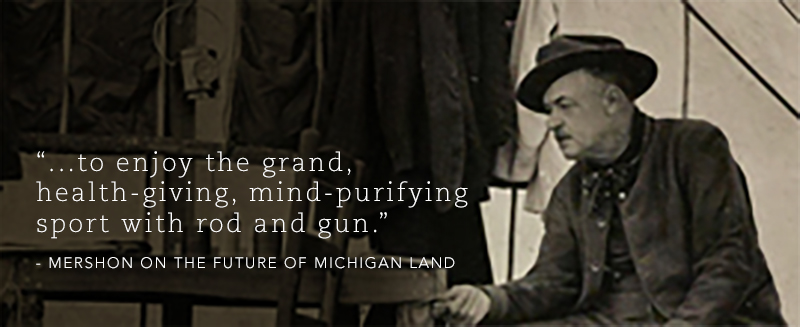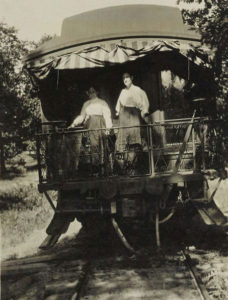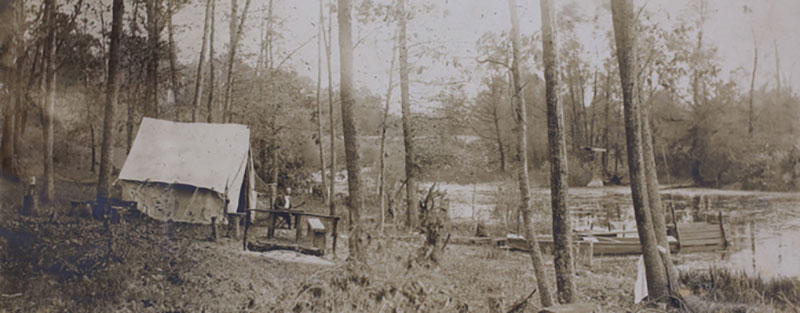News Stories
From The Digital Archives: The Mershon Collection

Documenting a Changing Environment
INTRODUCTION
William B. Mershon was a Michigan lumberman who made his fortune logging Michigan’s vast forests in the late 19th and early 20th centuries. An avid outdoorsman, Mershon hunted and fished in Michigan, and became a witness first to the excessive bounty of Michigan’s wilderness, and then to the dramatic loss of species, including the disappearance of the passenger pigeon and Michigan’s iconic grayling fish.
Mershon ultimately turned his attention to trying to collect information about fish habitats around the state, as well as working to preserve land and rivers for hunting. Today, his records of fish and game hauls—as well as his letters and journal entries with detailed information about the local landscape—provide a wealth of information regarding Michigan’s native environment.
Thanks to a generous gift by Thomas Buhr, the Bentley Historical Library was able to digitize the Mershon collection, including his diaries, letters, photographs, and more. For more on the contents of this incredible collection, continue below—and click the photos to link directly to the digitized materials.
The Allure of Fly Fishing
![Fully kitted-out and ready to fish during a Mershon family trip to their Au Sable lodge, 1912. [Family and camping snapshots, 1907-1919, Box 47, Folder 19].](https://bentley.umich.edu/wp-content/uploads/2017/03/crop-flyfishing-mershon-1-233x300.jpg)
Fully kitted-out and ready to fish during a Mershon family trip to their Au Sable lodge, 1912. [Family and camping snapshots, 1907-1919, Box 47, Folder 19]
The Mershon archives are filled with references to the sport. Fish counts, with detailed descriptions of conditions, fill notebooks with astonishing numbers of trout pulled from Michigan rivers. Family photos show the style and accessory of the well-kitted angler, while landscapes and backgrounds illuminate the ever-changing face of Michigan’s outdoors. Mershon spent a great deal of effort compiling data, in part to prove his perception of fly fishing as less destructive to fish stocks than traditional fishing. Hundreds of pages in the archive document early efforts to regulate fishing in Michigan and provide an invaluable resource in understanding the legal history of fish and wild life management in Michigan. All combine to make the Mershon archive among the finest, most comprehensive collections on the subject.
Today, as a testimony to his passion, Mershon’s name is attached to a number sporting and outdoor organizations including Trout Unlimited.
![Entries for an Au Sable River fishing trip from the summer of 1898, including an astonishing 757 trout caught on June 3. Au Sable 1898-1911 [Box 43, Folder 2].](https://bentley.umich.edu/wp-content/uploads/2017/03/cropped-mershon1898-journal.png)
Entries for an Au Sable River fishing trip from the summer of 1898, including an astonishing 757 trout caught on June 3. [Au Sable 1898-1911, Box 43, Folder 2]
“Camping” with the Mershons
![Left: W.B. Mershon and companions aboard a private rail car during one of their many hunting and fishing trips. Family and camping snapshots., 1907-1919 [Box 47, Folder 19]. Right: W.B. Mershon "roughing it" during a camping trip. Family and camping snapshots, 1907-1919. [Box 47, Folder 19].](https://bentley.umich.edu/wp-content/uploads/2017/03/campingmershon-new.jpg)
Left: W.B. Mershon and companions aboard a private rail car during one of their many hunting and fishing trips. Right: W.B. Mershon “roughing it” during a camping trip. [Family and camping snapshots, 1907-1919. Box 47, Folder 19].
Often, Mershon’s fishing and hunting trips with family and friends were taken in his private rail car. Porters and cooks would sometimes be hired and, as is apparent from these photos, many of the conveniences of home were taken into the bush. His archives contain innumerable references to these trips through diaries, fish counts, photographs, letters, and written memories.

 Mershon had two cars, the earliest the “City of Saginaw” and the later “W.B Mershon.” These cars included sleeping berths, dining areas, an ice box to store fish and game, and even a bathing tub. For many years, every October, the car would travel to the Dakotas for goose and quail hunts. In November the hunting party would be in northern Michigan to hunt partridge. May marked the annual Mershon family’s trout-fishing outing to the north branch of the Au Sable River. The train car would be brought to Lovells, Michigan, where Mershon owned hundreds of riverside acres. Later, Mershon would build his High Banks Lodge there.
Mershon had two cars, the earliest the “City of Saginaw” and the later “W.B Mershon.” These cars included sleeping berths, dining areas, an ice box to store fish and game, and even a bathing tub. For many years, every October, the car would travel to the Dakotas for goose and quail hunts. In November the hunting party would be in northern Michigan to hunt partridge. May marked the annual Mershon family’s trout-fishing outing to the north branch of the Au Sable River. The train car would be brought to Lovells, Michigan, where Mershon owned hundreds of riverside acres. Later, Mershon would build his High Banks Lodge there.
The loss of game populations, fish species and hunting areas are—often unknowingly—all recorded in the archive.
Michigan’s Grayling
![Michigan grayling taken from the Black River, 1903. ['Recollections of My Fifty Years Hunting and Fishing' (photos used in book), Box 47, Folder 17].](https://bentley.umich.edu/wp-content/uploads/2017/03/grayling1.jpg)
Michigan grayling taken from the Black River, 1903. [‘Recollections of My Fifty Years Hunting and Fishing’ (photos used in book), Box 47, Folder 17]
![Detail of the dorsal fin of an 18.f inch grayling caught on Michigan's Little Mansitee River in 1888. [Recollections of My Fifty Years Hunting and Fishing (photos used in book), Box 47, Folder 17]](https://bentley.umich.edu/wp-content/uploads/2017/03/grayling-fin-300x135.jpg)
Detail of the dorsal fin of an 18.f inch grayling caught on Michigan’s Little Mansitee River in 1888. [Recollections of My Fifty Years Hunting and Fishing (photos used in book) Box 47, Folder 17]
There are hundreds of references to grayling in the Mershon collection, including diary entries, early photos, and catch records that speak of some of the last graylings caught on the Au Sable and Black Rivers.
Ironically, it was lumbering, the source of the Mershon family fortune, that had the greatest impact on the destiny of the grayling. Detritus from mills, saw dust, and logs clogged rivers. Soil runoff silted spawning grounds, and the lack of leaf cover made the water warmer and less habitable.
![Left: A 1902 diary entry detailing some of the last grayling caught in the Black River. Of the 339 fish caught in five days, forty-four were grayling, and some as big as trout. [Au Sable, 1898-1911, Box 43, Folder 2].](https://bentley.umich.edu/wp-content/uploads/2017/03/Grayling-combo.jpg)
A 1902 diary entry detailing some of the last grayling caught in the Black River. Of the 339 fish caught in five days, forty-four were grayling, and some as big as trout. [Au Sable, 1898-1911, Box 43, Folder 2]
Looking for Fish, Offering a Window into the Past

Detail from 1914 line drawing showing how individual male fish can be identified by their lateral stripes. [Fish and fish habits (drawings), Box 47, Folder 6]
![A beautiful detail of the water current and breeding grounds of the Eastern blacknose dace (Rhinichthys atratulus) in Malletts Creek, a tributary of the Huron River, near Ann Arbor. [Fish and fish habits (drawings), Box 47, Folder 6].](https://bentley.umich.edu/wp-content/uploads/2017/03/mallettscreek.jpg)
A beautiful detail of the water current and breeding grounds of the Eastern blacknose dace (Rhinichthys atratulus) in Malletts Creek, a tributary of the Huron River, near Ann Arbor. [Fish and fish habits (drawings), Box 47, Folder 6]

A camp on the Huron River to survey the breeding ground of the dogfish near Ann Arbor, Michigan. [Fish and fish habits (including breeding areas), Box 47, Folder 5]
A Michigan Legacy
Mershon was active in Saginaw, Michigan, political life, serving as mayor of Saginaw (1894-1895), city alderman, member of both the parks and the cemetery commissions, and the citizen’s water committee. He gained recognition for his 1907 monograph on the passenger pigeon and, in 1927, published Recollections of My Fifty Years Hunting and Fishing, a memoir of his lifelong love of the outdoors.
William B. Mershon died on July 12, 1943 and his papers were donated to the Bentley Historical Library the following year by his family.
Click here to view the fully digitized Mershon collection.
